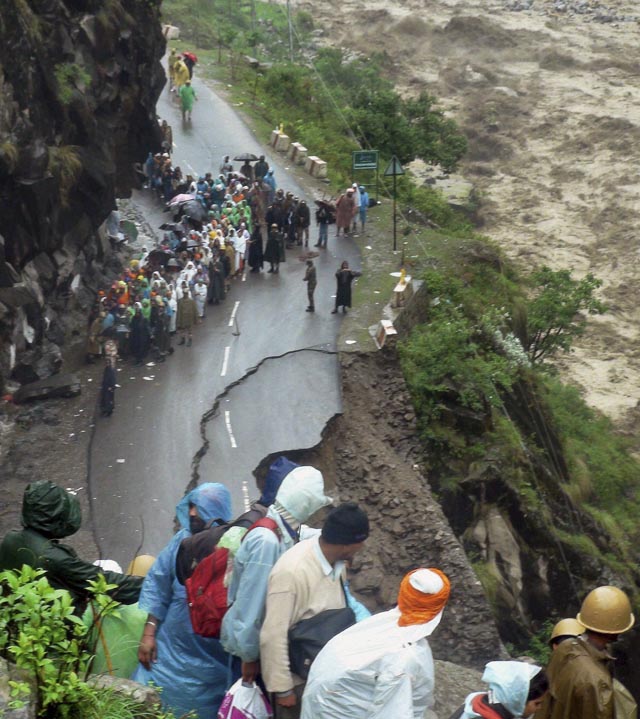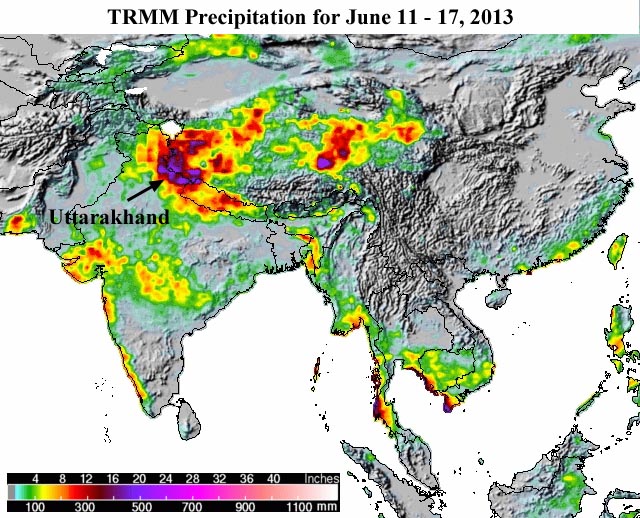Uttarakhand Spate: World’s 4th Deadliest Weather Disaster


July 15, 2013: Over five thousand people missing in the wake of the devastating flooding that hit India's Himalayan Uttarakhand region on June 14 - 17, 2013, have now been declared dead, making the disaster India's deadliest monsoon flood event on record, and Earth's 4th deadliest weather-related disaster since 2000. The death toll of 5,748 tops India's previous record worst monsoon flood death toll of 4892, set in July 1968 in Rajasthan and Gujara provinces. According to the Indian Meteorological Department, Uttarakhand, which lies just to the west of Nepal in the Himalayas, received rainfall 847% of normal during the week June 13 - 19, 2013. Dehradun, the capital of Uttarakhand, received 14.57" (370 mm) of rain in 24 hours on June 16 - 17, the highest 24-hour rainfall in city history. The torrential rains triggered a massive landslide that hit Uttarakhand's Hindu shrine in Kedarnath, which lies just a short distance from the snout of two mountain glaciers. The shrine is an important pilgrimage destination in June, and was packed with visitors celebrating a religious holiday. The June 2013 monsoon rains in Uttarakhand were highly unusual, as the monsoon came to the region two weeks earlier than normal. The monsoon started in South India near the normal June 1 arrival date, but then advanced across India in unusually rapid fashion, arriving in Pakistan along the western border of India on June 16, a full month earlier than normal. This was the fastest progression of the monsoon on record. The previous record for fastest monsoon progression occurred in 1961, when all of India was under monsoon conditions by June 21. Reliable monsoon records go back to 1961. Dr. Dave Petley's Landslide Blog has an excellent analysis of the event. He writes: "The important factor here is that the rainfall fell at a time when there was still snow on the ground--and any high mountain landslide expert will tell you that the combination of heavy rainfall on melting snow is the tailor-made for landslides."
India's 2013 Flood Earth's 4th deadliest weather-related disaster since 2000
This summer's flooding tragedy in India is the globe's fourth-deadliest weather-related disaster since the year 2000, according to EM-DAT, the International Disaster Database. Only Myanmar's Cyclone Nargis in 2008 and heat waves in Europe in 2003 and Russia in 2010 killed more people. However, global flood deaths have not been trending upwards over the past decade. Deaths due to floods and storms declined during the decade of 2001 - 2010, compared to the previous decade. A report issued earlier this month by the World Meteorological Organization titled, 2001-2010, A Decade of Climate Extremes, found that there was a 16% decline in deaths due to storms and 43% decline in deaths from floods, thanks mainly to better early warning systems and increased preparedness and despite an increase in populations in disaster-prone areas. The bad news is that weather-related deaths as a whole increased by 20% during the decade of 2001 - 2010, compared to 1991 - 2000, due to the huge number of deaths from the European heat wave of 2003 and the Russian heat wave of 2010. Less than 6000 people died in heat waves during 1991-2000, compared to 136,000 heat wave deaths in 2001-2010.
Earth's Deadliest Weather-Related Disasters Since 2000
1) Cyclone Nargis, Mayanmar, 2008: 138,366
2) Heat wave, Europe, 2003: 71,310
3) Heat wave, Russia, 2010: 55,736
4) Flood, India, 2013: 5,748
5) Cyclone Sidr, Bangladesh, 2007: 4234
6) Heat wave, Europe, 2006: 3418
7) Hurricane Jeanne, Haiti: 2004, 2754
8) Flood, Haiti, May 2004: 2665
9) Flood, Pakistan, 2010: 1985
10) Typhoon Bopha, Philippines: 2012, 1901
11) Hurricane Katrina, U.S., 2005: 1833
12) Landslide, China, 2010: 1765
Monsoons in India: a primer
Disastrous monsoon floods are common in India and surrounding nations, and 60,000 people have died in floods between 1950 - 2012, according to EM-DAT, the International Disaster Database. EM-DAT lists seventeen flood disasters which killed 1,000 or more people in India since records began in 1950. Here are the number of people killed in these events, along with the month and year of occurrence and locales affected:
5,748, Jun 2013, Uttarakhand
4892, Jul 1968, Rajasthan, Gujara
3800, Jul 1978, North, Northeast
2001, May - Oct, 1994, Assam, Arunachal Pradesh
2000, Jul 1961, North
1811, Aug 1998, Assam, Arunachal, Bihar
1600, Aug 1980, Uttar Pradesh, Bihar
1591, Jul 28, 1989, Maharashtra, Andhra Prade
1479, Sep 1995, Bihar, Haryana, Punjab
1442, Aug 1997, Andhra Pradesh, Arunachal
1200, Jul 24 - Aug 5, 2005 Gujarat, Madhya Pradesh
1200, Aug 1987, Assam, Bihar, West Bengal
1103, Jul 3 - Sep 22, 2007, Bihar, Uttar Pradesh
1063, Jun 11 - Jul 21, 2008 West Bengal, Orissa
1023, Jun 1971, North
1000, Sep 22 - Oct 9, 1988, Punjab, Himachal Pradesh
1000, Sep - Oct 1968
1000, Oct 1961
The monsoon occurs in summer, when the sun warms up land areas more strongly than ocean areas. This happens because wind and ocean turbulence mix the ocean's absorbed heat into a "mixed layer" approximately 50 meters deep, whereas on land, the sun's heat penetrates at a slow rate to a limited depth. Furthermore, due to its molecular properties, water has the ability to absorb more heat than the solid materials that make up land. As a result of this summertime differential heating of land and ocean, a low pressure region featuring rising air develops over land areas. Moisture-laden ocean winds blow towards the low pressure region and are drawn upwards once over land. The rising air expands and cools, condensing its moisture into some of the heaviest rains on Earth--the monsoon. Monsoons operate via the same principle as the familiar summer afternoon sea breeze, but on a grand scale. Each summer, monsoons affect every continent on Earth except Antarctica, and are responsible for life-giving rains that sustain the lives of billions of people. In India, home for over 1.1 billion people, the monsoon provides 80% of the annual rainfall.
Source: wunderground.com, DT. July 15, 2013.







